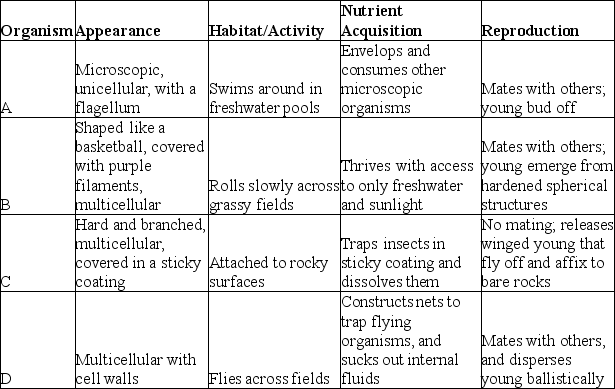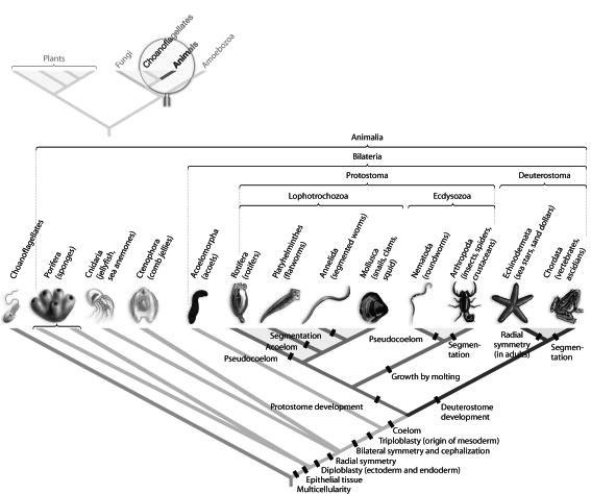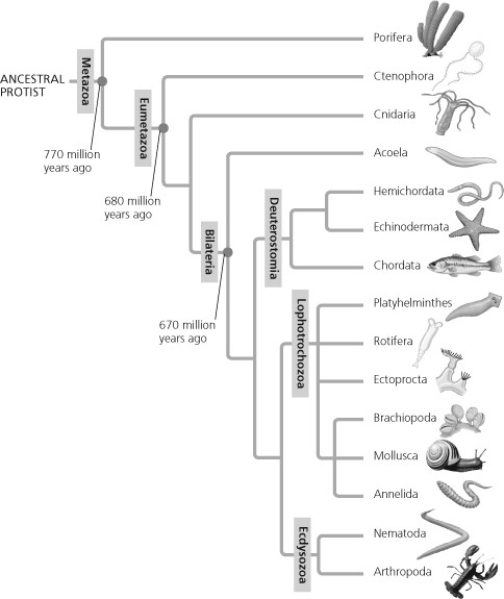A) the emergence of predator-prey relationships
B) an increase in the concentration of atmospheric oxygen
C) the movement of animals onto land
D) the origin of Hox genes
Correct Answer

verified
Correct Answer
verified
Multiple Choice
What was an early selective advantage of a coelom in animals? A coelom ________.
A) contributed to a hydrostatic skeleton, allowing greater range of motion
B) was a more efficient digestive system
C) allowed cephalization and the formation of a cerebral ganglion
D) allowed asexual and sexual reproduction
Correct Answer

verified
A
Correct Answer
verified
Multiple Choice
Use the information to answer the question. One small animal phylum (Placozoa) contains only two species, Trichoplax adhaerens (T. adhaerens) and T. reptans. T. adhaerens is the only species seen in over a century. Individuals are about 1 mm wide and only 27 μm high, are irregularly shaped, and consist of a total of about 2,000 cells, which are diploid (2n = 12) . There are four types of cells, none of which are nerve or muscle cells, and none of which have cell walls. Individual animals move using cilia, and any "edge" can lead. T. adhaerens feeds on marine microbes, mostly unicellular green algae, by crawling atop the algae and trapping it between its ventral surface and the substrate. Enzymes are then secreted onto the algae, and the resulting nutrients are absorbed. T. adhaerens sperm cells have never been observed. Embryos up to, but not past, the 64-cell (blastula) stage have been observed. On the basis of information in the paragraph, which of these should be able to be observed in T. adhaerens?
A) a coelom
B) the process of gastrulation
C) eggs
D) a radially symmetric larval form
Correct Answer

verified
Correct Answer
verified
Multiple Choice
Sponges and ctenophores have both been proposed as basal metazoans. Which of the following types of data support the idea that sponges are the basal group?
A) sequences of cadherin genes, cleavage type, structure of collar cells, and bilateral symmetry of adults
B) sequences of collagen genes, bilateral symmetry of adults, cleavage type, and fossil steroids
C) fossil steroids, molecular clock, lack of tissues in sponges, and structure of collar cells
D) structure of collar cells, bilateral symmetry of larvae, sequences of cadherin genes, and molecular clock
Correct Answer

verified
Correct Answer
verified
Multiple Choice
The larvae of some insects are merely small versions of the adult, whereas the larvae of other insects look completely different from adults, eat different foods, and may live in different habitats. Which of the following is most directly involved in the evolution of these variations in metamorphosis?
A) artificial selection of sexually immature forms of insects
B) changes in the homeobox genes controlling early development
C) the evolution of meiosis
D) the origin of a brain
Correct Answer

verified
Correct Answer
verified
Multiple Choice
Use the table to answer the following question.
 As you are on the way to Tahiti for a vacation, your plane crash lands on a previously undiscovered island. You soon find that the island is teeming with unfamiliar organisms, and you, as a student of biology, decide to survey them (with the aid of the Insta-Lab Portable Laboratory you brought along in your suitcase) . You select four organisms and observe them in detail, making the notations found in the figure.
In which of the organisms listed would you search for collagen?
As you are on the way to Tahiti for a vacation, your plane crash lands on a previously undiscovered island. You soon find that the island is teeming with unfamiliar organisms, and you, as a student of biology, decide to survey them (with the aid of the Insta-Lab Portable Laboratory you brought along in your suitcase) . You select four organisms and observe them in detail, making the notations found in the figure.
In which of the organisms listed would you search for collagen?
A) organism A
B) organism B
C) organism C
D) organism D
Correct Answer

verified
Correct Answer
verified
Multiple Choice
Which of these statements, if accurate, would support the claim that the ancestral cnidarians had bilateral symmetry?
A) Cnidarian larvae possess anterior-posterior, left-right, and dorsal-ventral aspects.
B) Cnidarians have fewer Hox genes than bilaterians.
C) All cnidarians are acoelomate.
D) The presence of collar cells.
Correct Answer

verified
Correct Answer
verified
Multiple Choice
Use the information to answer the question. Trichoplax adhaerens is the only living species in the phylum Placozoa. Individuals are about 1 mm wide and only 27 μm high, are irregularly shaped, and consist of a total of about 2,000 cells, which are diploid (2n = 12) . There are four types of cells, none of which are nerve or muscle cells, and none of which have cell walls. Individual animals move using cilia, and any "edge" can lead. T. adhaerens feeds on marine microbes, mostly unicellular green algae, by crawling atop the algae and trapping it between its ventral surface and the substrate. Enzymes are then secreted onto the algae, and the resulting nutrients are absorbed. T. adhaerens sperm cells have never been observed, nor have embryos past the 64-cell (blastula) stage. t. adhaerens' body symmetry seems to be most like that of ________.
A) most sponges
B) cnidarians
C) worms
D) tetrapods
Correct Answer

verified
Correct Answer
verified
Multiple Choice
Both animals and fungi are heterotrophic. What distinguishes animal heterotrophy from fungal heterotrophy is that most animals derive their nutrition by ________.
A) preying on animals
B) ingesting materials
C) consuming living, rather than dead, prey
D) using enzymes to digest their food
Correct Answer

verified
Correct Answer
verified
Multiple Choice
Evidence of which structure or characteristic would be most surprising to find among fossils of the Ediacaran fauna?
A) true tissues
B) hard parts
C) bilateral symmetry
D) embryos
Correct Answer

verified
B
Correct Answer
verified
Multiple Choice
What do animals ranging from corals to monkeys have in common?
A) a mouth and an anus
B) number of embryonic tissue layers
C) some type of body symmetry
D) presence of Hox genes
Correct Answer

verified
Correct Answer
verified
Multiple Choice
You have before you a living organism, which you examine carefully. Which of the following should convince you that the organism is acoelomate?
A) It is triploblastic.
B) It has bilateral symmetry.
C) It possesses sensory structures at its anterior end.
D) Muscular activity of its digestive system distorts the body wall.
Correct Answer

verified
Correct Answer
verified
Multiple Choice
You find a new species of worm and want to classify it. Which of the following lines of evidence would allow you to classify the worm as a nematode and not an annelid?
A) It is segmented.
B) It is triploblastic.
C) It has a coelom.
D) It sheds its external skeleton to grow.
Correct Answer

verified
Correct Answer
verified
Multiple Choice
Sponges and ctenophores have both been proposed as basal metazoans. Imagine that you wanted to provide additional evidence to help resolve this question. Which of the following projects would be the best next step?
A) more extensive study of DNA sequences in the bilateria
B) ultrastructural (that is, electron microscope) comparisons of choanoflagellates and sperm cells from arthropods
C) measurements of molecular clocks from the Lophotrochozoa
D) more extensive studies of DNA sequences in both groups
Correct Answer

verified
B
Correct Answer
verified
Multiple Choice
Suppose a researcher for a pest-control company developed a chemical that inhibited the development of an embryonic mosquito's endodermal cells. Which of the following would be a likely mechanism by which this pesticide works?
A) The mosquito would develop a weakened exoskeleton that would make it vulnerable to trauma.
B) The mosquito would have trouble digesting food, due to impaired gut function.
C) The mosquito would have trouble with respiration and circulation, due to impaired muscle function.
D) The mosquito wouldn't be affected at all.
Correct Answer

verified
Correct Answer
verified
Multiple Choice
At one time, sponges were lumped into one phylum. Then, they were separated into several different phyla. Now, they are considered one phylum again. These changes indicate which of the following?
A) Every phylogeny should be considered a hypothesis that must be revised in the light of new data.
B) We need more fossil evidence of sponges.
C) Molecular and morphological data often conflict when we try to reconstruct evolutionary history.
D) The goal of making all taxonomic groups monophyletic is unrealistic.
Correct Answer

verified
Correct Answer
verified
Multiple Choice
Use the figure to answer the question.
 Which morphological trait evolved more than once in animals, according to the phylogeny based on DNA sequence data found in the figure?
Which morphological trait evolved more than once in animals, according to the phylogeny based on DNA sequence data found in the figure?
A) coelom
B) bilateral symmetry
C) segmentation
D) protostome development
Correct Answer

verified
Correct Answer
verified
Multiple Choice
 Based on the tree shown, which statement is false?
Based on the tree shown, which statement is false?
A) The animal kingdom is monophyletic.
B) Acoelomate flatworms are more closely related to echinoderms than to annelids.
C) Sponges are basal animals.
D) Bilaterians form a clade.
Correct Answer

verified
Correct Answer
verified
Multiple Choice
Soon after the coelom begins to form, a researcher injects a dye into the coelom of a deuterostome embryo. Initially, the dye should be able to flow directly into the ________.
A) blastopore
B) blastocoel
C) archenteron
D) pseudocoelom
Correct Answer

verified
Correct Answer
verified
Multiple Choice
Some researchers claim that sponge genomes have homeotic genes, but no Hox genes. If true, this finding would ________.
A) mean that sponges must no longer be classified as animals
B) confirm the identity of sponges as "basal animals"
C) mean that extinct sponges must have been the last common ancestor of animals and fungi
D) require sponges to be reclassified as choanoflagellates
Correct Answer

verified
Correct Answer
verified
Showing 1 - 20 of 67
Related Exams